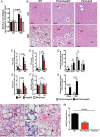Perilipin-2 promotes obesity and progressive fatty liver disease in mice through mechanistically distinct hepatocyte and extra-hepatocyte actions
- PMID: 30536914
- PMCID: PMC6418763
- DOI: 10.1113/JP277140
Perilipin-2 promotes obesity and progressive fatty liver disease in mice through mechanistically distinct hepatocyte and extra-hepatocyte actions
Abstract
Key points: Wild-type mice and mice with hepatocyte-specific or whole-body deletions of perilipin-2 (Plin2) were used to define hepatocyte and extra-hepatocyte effects of altered cellular lipid storage on obesity and non-alcoholic fatty liver disease (NAFLD) pathophysiology in a Western-diet (WD) model of these disorders. Extra-hepatocyte actions of Plin2 are responsible for obesity, adipose inflammation and glucose clearance abnormalities in WD-fed mice. Hepatocyte and extra-hepatic actions of Plin2 mediate fatty liver formation in WD-fed mice through distinct mechanisms. Hepatocyte-specific actions of Plin2 are primary mediators of immune cell infiltration and fibrotic injury in livers of obese mice.
Abstract: Non-alcoholic fatty liver disease (NAFLD) is an obesity- and insulin resistance-related metabolic disorder with progressive pathology. Perilipin-2 (Plin2), a ubiquitously expressed cytoplasmic lipid droplet scaffolding protein, is hypothesized to contribute to NAFLD in humans and rodent models through effects on cellular lipid metabolism. In this study, we delineate hepatocyte-specific and extra-hepatocyte Plin2 mechanisms regulating the effects of obesity and insulin resistance on NAFLD pathophysiology in mice fed an obesogenic Western-style diet (WD). Total Plin2 deletion (Plin2-Null) fully protected WD-fed mice from obesity, insulin resistance, adipose inflammation, steatohepatitis (NASH) and liver fibrosis found in WT animals. Hepatocyte-specific Plin2 deletion (Plin2-HepKO) largely protected against NASH and fibrosis and partially protected against steatosis in WD-fed animals, but it did not protect against obesity, insulin resistance, or adipose inflammation. Significantly, total or hepatocyte-specific Plin2 deletion impaired WD-induced monocyte recruitment and pro-inflammatory macrophage polarization found in livers of WT mice. Analyses of the molecular and cellular processes mediating steatosis, inflammation and fibrosis identified differences in total and hepatocyte-specific actions of Plin2 on the mechanisms promoting NAFLD pathophysiology. Our results demonstrate that hepatocyte-specific actions of Plin2 are central to the initiation and pathological progression of NAFLD in obese and insulin-resistant mice through effects on immune cell recruitment and fibrogenesis. Conversely, extra-hepatocyte Plin2 actions promote NAFLD pathophysiology through effects on obesity, inflammation and insulin resistance. Our findings provide new insight into hepatocyte and extra-hepatocyte mechanisms underlying NAFLD development and progression.
Keywords: Fibrosis; Insulin Resistance; Nonalcoholic Steatohepatitis; Obesity; Perilipin-2.
© 2018 The Authors. The Journal of Physiology © 2018 The Physiological Society.
Figures






Comment in
-
Hepatocyte-specific and extra-hepatocyte actions of perilipin-2 during fatty liver disease: benefits of being extra.J Physiol. 2019 Mar;597(6):1431-1432. doi: 10.1113/JP277539. Epub 2019 Jan 29. J Physiol. 2019. PMID: 30656685 Free PMC article. No abstract available.
References
-
- Bertola A, Bonnafous S, Anty R, Patouraux S, Saint‐Paul MC, Iannelli A, Gugenheim J, Barr J, Mato JM, Le Marchand‐Brustel Y, Tran A & Gual P (2010). Hepatic expression patterns of inflammatory and immune response genes associated with obesity and NASH in morbidly obese patients. PLoS One 5, e13577. - PMC - PubMed
-
- Brasaemle DL (2007). The perilipin family of structural lipid droplet proteins: Stabilization of lipid droplets and control of lipolysis. J Lipid Res 48, 2547–2549. - PubMed
-
- Brunt EM, Wong VW, Nobili V, Day CP, Sookoian S, Maher JJ, Bugianesi E, Serlin CB, Neuschwander‐Tetri BA & Rinella M (2015). Nonalcoholic fatty live disease. Nat Rev Dis Primers 1, 22. - PubMed
Publication types
MeSH terms
Substances
Grants and funding
LinkOut - more resources
Full Text Sources
Other Literature Sources
Medical
Molecular Biology Databases
Research Materials

